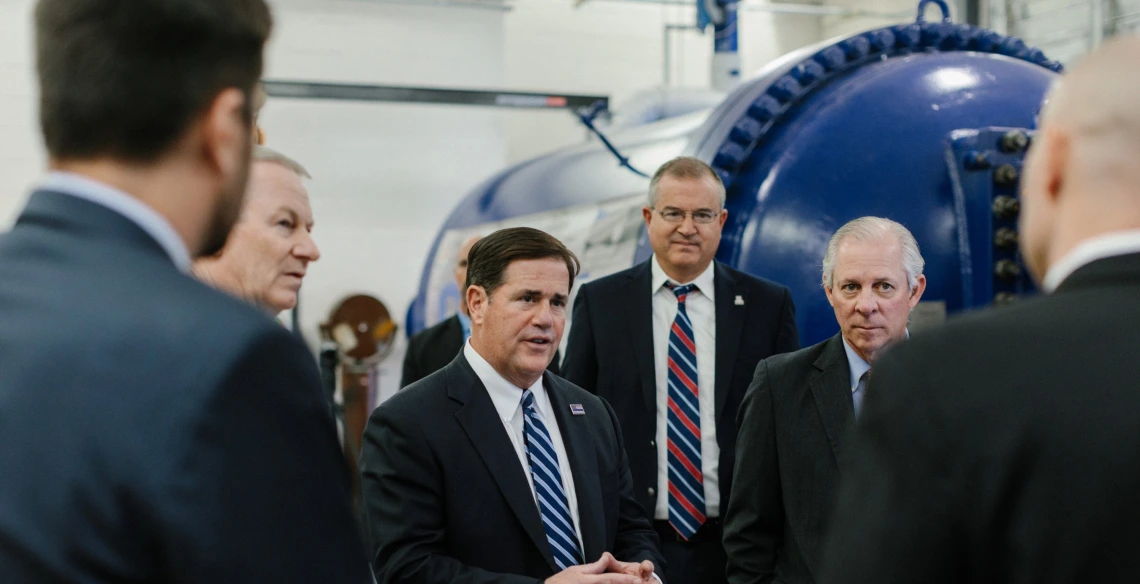Gov. Ducey Says Investment in Hypersonic Flight is Ticket to the Future
The governor joined Raytheon Missiles & Defense president, university leadership, and representatives from the education sector to tour UArizona wind tunnels and discuss the state's STEM workforce.

Gov. Doug Ducey (third from left) toured wind tunnels on the UArizona campus on Dec. 2, along with University of Arizona President Robert C. Robbins (fifth from left), Raytheon Missiles & Defense president Wes Kremer (second from left), Craig M. Berge Dean of the College of Engineering David W. Hahn (fourth from left) and aerospace and mechanical engineering faculty members Alex Craig (far left) and Jesse Little (far right). (Photo: Raytheon Missiles & Defense)
Gov. Doug Ducey visited the University of Arizona campus Thursday to see the state's New Economy Initiative in action. The initiative is geared toward building a highly educated workforce to meet some of the world's most pressing technological challenges. Its fiscal year 2022 funding included support for UArizona research in hypersonic flight – flight at five times the speed of sound and faster.
"The technology is really mind blowing," Ducey said during his visit to campus. "Hypersonics are a central part of the future of engineering, and, consequently, they will be a central part of the future of our workforce. It's a no-brainer for the state of Arizona to invest in this project."
Ducey toured the College of Engineering's wind tunnels – along with Raytheon Missiles & Defense President Wes Kremer, University of Arizona President Robert C. Robbins, Craig M. Berge Dean of the College of Engineering David W. Hahn, and aerospace and mechanical engineering faculty members Alex Craig and Jesse Little.
"Growing our College of Engineering has been a priority since the beginning of my time here as president, so I am very excited for these developments and for what this partnership will mean not only for the University of Arizona but for our state," Robbins said after the event. "I am so grateful to Governor Doug Ducey and Wes Kremer for being such outstanding partners as we enhance workforce development and research to build a better future for us all."
"Being able to have not only hypersonics capabilities, but being able to defend against hypersonics, is something that is not only important today, but is growing in importance every single day," Kremer said. "Unlike many areas of science, where we have decades of experience, this is an area that's truly emerging."
Vehicles traveling at high speeds, he explained, generate high levels of heat, creating a multidimensional engineering challenge that requires expertise in materials science, propulsion techniques and thermodynamics. Wind tunnels like those on the UArizona campus allow the university and industry partners to conduct experiments with all of these principles in play.
Ducey echoed the importance of wind tunnel research, especially considering how much other countries are investing in hypersonic technology.
"Not only is what we're seeing critical to the future of our economy, it's critical to the future of our national defense," he said. "And it's happening right here in Tucson, Arizona. It's happening right here at the University of Arizona."
The group held a roundtable discussion about the future of the science, technology, engineering and math workforce in Arizona. Also present were Kate Hoffman, founder and CEO of Earn to Learn; Steve Holmes, superintendent of Sunnyside Unified School District; Lee Lambert, chancellor and CEO of Pima Community College; Ted Maxwell, president and CEO of the Southern Arizona Leadership Council; and Kathy Prather, superintendent and CEO of Pima JTED.
Hahn said the people at the roundtable represented a microcosm of the reasons he came to the university in 2019. Among them: a forward-looking state legislature and support from university leadership for ambitious growth goals – including doubling the size of the College of Engineering's undergraduate student population.
"The New Economy Initiative investments are already providing a return on investment," he said. "I'm confident that we'll continue to leverage that to grow this college, grow this industry and provide jobs. At the end of the day, this three-way partnership between the state, the University of Arizona and industry is really the model of success to ensure our competitive edge in the state of Arizona."

